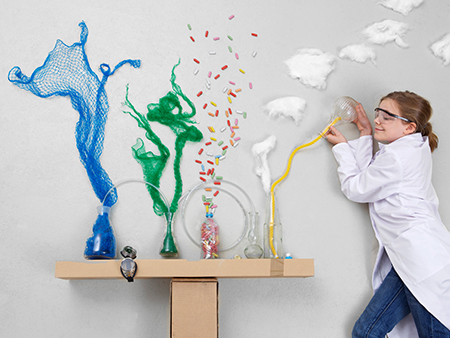 Avoid summer brain drain with these fun experiments that focus on science and math.Studies have shown that summer learning loss is real and evident in our children. And many parents struggle with how to engage their kids while still making learning fun.
Avoid summer brain drain with these fun experiments that focus on science and math.Studies have shown that summer learning loss is real and evident in our children. And many parents struggle with how to engage their kids while still making learning fun.
Rosianna Gray, Ph.D., an assistant professor in the University of Alabama at Birmingham College of Arts and Sciences, works with community partners to find ways to incorporate science into fun activities.
“With these activities, students are able to hone their skills in science, math, technology and reading,” Gray said. “Implementation and exposure to the wonderful world of STEM should be done at a young age to get a desired successful impact later in their academic path. Identifying engaging activities can make science enjoyable and fun for all ages.”
Gray uses the following activities as part of a nonprofit organization, Our Firm Foundation, that focuses on STEM exposure and mentoring. The community program introduces students to science and gauges their learning over time.
Gray adapts experiments from other sources and previous teaching experiences to fit a third- and fourth-grade curriculum. She encourages parents and caregivers to try a fun activity with their children to open their minds to the world of science.
Can glue bounce? Fun with glue and borax
The objective of this experiment is to demonstrate the difference between a chemical change and physical change.
Physical changes are about energy and those changes that relate to solids, liquids or gases, such as an ice cube’s melting. Chemical changes are smaller and happen at a more intense level, such as color changes.
In conducting this experiment, children will see how physical changes are made when combining the two mixtures to create “flubber.” Chemical changes are shown through the use of heat in the form of a microwave.
Materials:
- Water
- Borax soap
- Microwave
- Glue
- Two beakers
- Stirring rod
- Food coloring in the child’s favorite color
- Gloves (because this experiment can be messy)
Procedure:
Put 1.5 inches of water in container A. Add one teaspoon of Borax soap to container A. Heat the mixture in the microwave for one minute and set aside. Be careful as the mixture will be hot.
Put 1.5 inches of glue in container B. Add six teaspoons of water to container B. Add 12 drops of food coloring to container B.
Add the contents of container A to the mixture in container B. Stir well. The combination makes “flubber.”
Can colors run? Fun with soap and colors
Materials:
- Six paper plates
- 1 percent milk
- 2 percent milk
- Half and half
- Buttermilk
- Whole milk
- Glue (to make a cool souvenir)
- Food coloring: green, blue, red and yellow
- Liquid dishing washing detergent
- Q-tips
Procedure:
Lay paper plates out into a straight line, one plate for each type of milk and glue. Pour various milks into the plates, enough to cover the bottom of each. Drop three or four drops of different food colorings into the center of the milk. Be careful not to mix the colors.
Dip a Q-tip into the liquid dishwashing detergent and place it in the center of the food coloring drops.
Watch and discuss what happens as each plate transitions to a beautiful piece of art.
Tasty bacteria: fun with milk, yogurt and heat
Microbes are used to produce a wide variety of foods through a process called fermentation. Fermentation refers to a metabolic process that releases energy from a sugar or other organic molecule. The process can be carried out with or without oxygen. In dairy fermentation, or yogurt production, microorganisms use lactose and produce lactic acid without using oxygen.
Materials:
- Homogenized milk
- Nonfat dry milk
- Plastic cups
- Plastic spoons
- Foil
- Thermometer
- 100-milliliter graduated cylinder
- Commercial yogurt
- Hot plate
Procedure
Heat the milk to 80 degrees Celsius for 10 to 20 minutes, stirring occasionally. Do not let it boil.
Cool milk to 65 degrees Celsius and add one teaspoon of nonfat dry milk per person. Stir to dissolve. Rapidly cool milk to about 45 degrees Celsius.
Inoculate each cup with one to two teaspoons of commercial plain yogurt and cover with foil. Incubate the cups at 45 degrees Celsius for four to eight hours or until they are firm or custardlike.
Cool the yogurt to about 5 degrees Celsius. Taste, add some type of flavor, like strawberries, peaches, granola, etc., and enjoy!
Here is how to convert Fahrenheit to Celsius:
- Determine the temperature in Fahrenheit
- Subtract 32
- Multiply the result times 5
- Divide that answer by 9
- Your final answer is the temperature in Celsisus
Here is how to convert Celsius to Fahrenheit:
- Multiply by 1.8 or 9/5
- Add 32
- Your final answer is the temperature in Farenheit